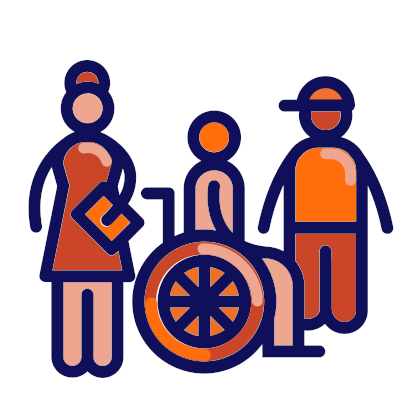Tackling discrimination

Schools can tackle discrimination by promoting democracy, respect for human rights and citizenship.
To ensure that all students’ needs are met equally, schools need to prioritise language and cultural competences, multiperspectivity in history and gender equality. In this way, students can acquire competences for democratic culture, to fulfil their potential in school as well as in society.
Facts & figures
Students with disabilities in Europe have higher early-school leaving-rates than their same-age peers.[1]
Black Caribbean students are three times more likely to be excluded from English schools than white pupils. [2]
A survey of nine EU countries showed that 33% of Roma students were in schools where most pupils were Roma, with 13% in Roma-only schools.[3]
What is discrimination?
Discrimination is treating a person badly or unfairly on account of a personal characteristic, such as national, ethnic or social origin, gender, language, religion, disability or sexual orientation.
There are two basic forms of discrimination:
- Direct discrimination – treating someone less favourably than you treat or would treat another person in the same situation, e.g., a school refusing to admit a student because they are Roma,
- Indirect discrimination – applying a provision, criterion or practice in the same way for all of a group which has the effect of unfairly disadvantaging people in the group who share a particular characteristic, e.g., a school uniform policy banning headgears for girls and boys may unfairly disadvantage Muslim girls and Jewish boys.
Discrimination can occur in almost any aspect of school life, from the attitudes and expectations of teachers to school rules and codes of conduct, selection and grouping practices, curricula, teaching methods and materials, changing facilities, career guidance, canteen food and the physical school environment.
Whatever form it takes – whether it be parallel school systems for different ethnic groups, concentrations of minority or disadvantaged children in the same school, or differential access to educational provision, it means a lower quality of educational experience for the students being discriminated against.
Why is tackling discrimination important at school?
Discrimination is a human rights violation. Article 14 of the European Convention on Human Rights contains a prohibition on discrimination with respect to any of the rights and freedoms guaranteed under the Convention. Article 2 of Protocol No.1 requires the state to ensure that all individuals have access to its formal educational provision.
“No person shall be denied the right to education.”[4]
“The enjoyment of the rights and freedoms set forth in this Convention shall be secured without discrimination on any ground such as sex, race, colour, language, religion, political or other opinion, national or social origin, association with a national minority, property, birth or other status.”[5]
Tackling discrimination is not simply a duty laid on schools by the European Convention of Human Rights, it is also important for student well-being and educational success. Children and young people who are treated unfairly or discriminated against are more likely to have:
- negative attitudes to school
- lower levels of motivation and academic achievement
- a higher risk of dropping out of formal education
- experience of bullying
- mental health problems.
Feeling different or ‘less’ than others can be an isolating experience. Over time it undermines an individual’s capacity for participation in society, e.g., their sense of self-efficacy, openness to other cultures and beliefs, tolerance of ambiguity and flexibility and adaptability - all of which lie at the heart of the Council of Europe Reference Framework of Competences for Democratic Culture.
Lack of opportunity due to discrimination in school also damages society. It intensifies social divisions, fuels xenophobia and intolerance and undermines social cohesion.
“States should adopt a combination of strong anti-discrimination measures and policies that promote more inclusive education systems where all children learn together. This is not a utopian project, but an achievable goal that can ensure more equal treatment of all children and, in the long term, improve social cohesion”[6]
What are the challenges?
One of the challenges facing the tackling of discrimination in schools is a lack of data. European-wide statistics specifically focused on discrimination in schools are scarce. Children with disabilities, for example, do not always appear in national statistics and may be ‘invisible’ to decision-makers, service providers and the public. Such children are particularly vulnerable to discrimination, however, and are often segregated in terms of educational provision.
These are not the only ‘invisible’ minorities in schools. For example, LGBTI students often feel they have to hide their sexual orientation at school to avoid victimisation.
Another key challenge is the existence of negative stereotypes about minority groups among teachers, parents, students and other school stakeholders. Such stereotypes are often deeply embedded in everyday school life and practice, so much so that they are taken as ‘normal’, e.g., stories and images in textbooks that reflect a stereotyped portrayal of the roles of women and men, girls and boys. Stereotypes help to fuel prejudiced and aggressive behaviour between students, lower expectations from teachers and negative attitudes from parents, e.g., refusing to allow their children to be taught alongside refugee or migrant children.
Stereotyping is difficult to root out in schools because its origins lie in wider society. This is exacerbated by the current preponderance of hate speech, fake news and conspiracy theories in digital media, especially social media.
The situation is compounded when minority groups are under-represented on school staff. Students lack role - models and teachers do not have the access to information about or insights into other cultures and ways of life that come with belonging to a more diverse profession. They lack the intercultural competences with which to create inclusive and quality learning environments, e.g., openness to cultural otherness, tolerance of ambiguity, plurilingual skills and knowledge and critical understanding of alternative cultures, religions and histories.
Tackling discrimination is more challenging when there is a lack of dialogue between schools and parents. Often this is on account of language difficulties, but it is also a problem where students’ parents work abroad leaving their children in the charge of elderly relatives or others.
How can schools get active?
Ensuring all learners of any age are provided with meaningful, high-quality educational opportunities alongside their peers requires a whole-school approach.
It begins by schools understanding who might be at risk of discrimination, what they can do to minimise discrimination and how they can support students at risk of discrimination. A good place to start is with an assessment of the current situation, identifying the strengths that exist in the school, but also needs and priorities. Consulting with school stakeholders is essential, especially students and, where possible, parents – e.g., using surveys, questionnaires, focus groups, etc. Given the sensitivities involved there is argument for collecting information on individuals’ experiences of discrimination anonymously.
Based on an assessment of the current situation it is possible to identify immediate priorities for policy development. Priorities will vary with the school, but might include, for example:
- language development
- gender equality
- accessibility of the physical environment
- intercultural competences.
The setting of initial priorities should go hand in hand with professional development for senior leadership teams as well as teaching staff. An element of personal as well as professional reflection is essential to the tackling of discrimination in school. In particular, it is important for school staff to be able to consider their own beliefs and values with regard to discrimination, including their own unconscious biases and prejudices.
Schools can then turn to the longer-term aspiration of creating a culture of non-discrimination. Central to this process is the challenging of negative stereotyping, both in classrooms and around the school. This can be done in a variety of ways, including:
- challenging stereotypes when they are heard
- discussing stereotypes with students
- identifying stereotypes in the curriculum
- highlighting stereotypical images and roles in textbooks
- allocating posts of responsibility equitably
- choosing different ways of dividing up students
- providing a range of role-models
- setting up mechanisms for monitoring incidents of discrimination.
Challenging stereotypes goes alongside the promotion of inclusion and an appreciation of the benefits of diversity in school life. This can take different forms, including:
- using inclusive language
- including human rights, democratic citizenship and intercultural education in the curriculum
- encouraging the discussion of controversial issues
- promoting student voice
- involving students in peer education and peer mediation activities
- welcoming parents and involving them in school decision-making
- forming partnerships with different organisations and groups in the community.
[1] Education section of the The European Disability Forum
[2] Article: UK: Racial discrimination is a reality in schools and classrooms. Education International
[3] EU Fundamental Rights Agency, “Second European Union Minorities and Discrimination Survey (EU-MIDIS II) Roma – Selected findings” (2017).
[4] ECHR, Article 2, Protocol No.1
[6] Position paper: Fighting school segregation in Europe through inclusive education by the Council of Europe Commissioner for Human Rights
 Resources on Tackling discrimination
Resources on Tackling discrimination
 Related schools projects
Related schools projects
Address: Blisterhaugveien 9 – 7079 Saupstad
Country: Norway
Project: ‘Democracy in practice’ an elective subject in school
 Working language during the project:
Working language during the project:
- Norwegian and English
 Themes of the Council of Europe campaign “FREE to SPEAK, SAFE to LEARN - Democratic Schools for All” covered:
Themes of the Council of Europe campaign “FREE to SPEAK, SAFE to LEARN - Democratic Schools for All” covered:
- Making children’s and students’ voices heard
- Addressing controversial issues
- Preventing violence and bullying
- Dealing with propaganda, misinformation and fake news
- Tackling discrimination
- Improving well-being at school
 Competences from the Reference Framework of Competences for Democratic Culture (CDC) addressed and where / how they were integrated:
Competences from the Reference Framework of Competences for Democratic Culture (CDC) addressed and where / how they were integrated:
 Target group age range:
Target group age range:
- 11 - 15 and 15 - 19
 Level of education:
Level of education:
- Lower secondary education
Short description of the project:
I teach an optional subject called Democracy in practice, so this is not a project. But the students select each year options from a variety of subjects. In Norway, there is of course a general overall teaching framework on everything that we do as teachers in school. And there are laws to follow on everything we carry out as a school towards our students. These laws describe the students’ rights in education. The Norwegian educational directorate has provided a manual that forms the basis of the subject, but the approach is also local. Each city or local community can develop their own version of the subject, as long as it contains the above-mentioned benchmarks that connect the overall teaching goals.
In 2013, I was asked to begin teaching this subject because the socio-economic conditions of the local community that I work in has since the 70’s been poor. At the national level, this often results in different actions and programmes for enhancing and improving these conditions. This also happens in other parts in Norway, as well as other countries near Norway.
Our aim was to implement a set of ways for thinking and acting, and to reflect on what to teach young people from different backgrounds on the topics which are the focus of this conference. It is fundamentally about how we learn as human beings to behave nicely to each other, how to live good lives, and how we can make this possible. How should we teach the different topics on the competences of this conference? We have chosen to do this in a practical way. We believe the following: if young people want to have their voices heard, to be raised by adults to have good values, they have to have the right set of skills. We use practical tasks, related to their own age group, and topics related to their daily experiences. We also involve them in the decision-making that concerns them. If we are building schools or playgrounds, or different leisure activities, parks, roads, art inside or outside, in their communities, they are heard. We as adults take their opinions on board in our decisions. This is often done through youth-councils. But we also do this in the classroom. We also travel across Norway to learn about democracy, controversial issues and peace work. We teach topics in different institutions and to different people. For example, the Norwegian government has its own cursus on topics like this. We organise meetings with members of parliament, we visit and work on school projects and the teachings of the Nobel peace-centre in Norway, we visit Utøya and teach controversial issues at the European Wergeland Center. We visited the 22.July Centre and work on violent radical-extremism. We discuss subjects such as ‘what do children and young people need to grow up and have good lives?’. We work with city planners, various artists and politicians before they take their decisions. We also work, on the softer side, on how to live good lives. We do this by addressing the above-mentioned descriptions on competences.
 Aims/objectives
Aims/objectives
To give young people a practical coping-toolbox on how to deal with the different obstacles they face both as young people and often as adults too. To teach them how to reflect upon different issues and within their own decision-making on topics and obstacles they will encounter.
 Expected results/outcomes
Expected results/outcomes
- To enhance their ability to reflect on life issues that are important to young people.
- To give them the tools that help both in critical situations and in coping with daily life-situations.
 Changes
Changes
We want to see our young people become robust and cope with their lives and aim to provide them that tools that will make this possible. The changes we hope for are in a way general, we want to contribute to our society through good teachings, and hope it rubs off on more people than those who sit in our classroom.
An average day on how we have to think as teachers on changes can be like this: you always have to adapt to various things throughout the school year, such as being on the alert with regard to what is happening in the world. The topics we are teaching cannot be taught without taking this into account. We live in a global world, and now that world is closer to all of us, mainly because of the internet. Everyone has the ability to get an update on almost anything just by ‘clicking’ on the world wide web. We as teachers and adult human beings need to be updated at all times with regard to how this world works if we are going be able to teach our children the good stuff!
 Challenges you faced
Challenges you faced
If I do not get any students, I have no one to teach!
 Time-frame of the project:
Time-frame of the project:
There are no estimated timeframe other than if the schools headmaster and his team decide to stop this elective subject.
 Council of Europe materials on citizenship and human rights education used while preparing or implementing your practice:
Council of Europe materials on citizenship and human rights education used while preparing or implementing your practice:
None but the things that we use are similar.







